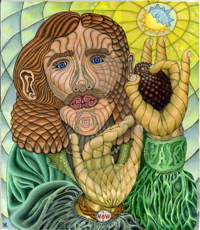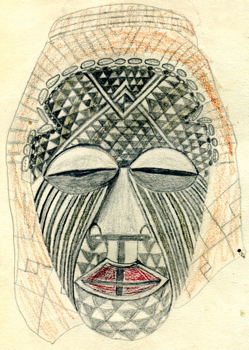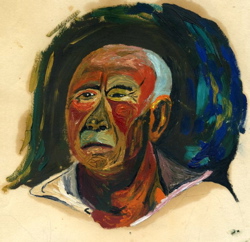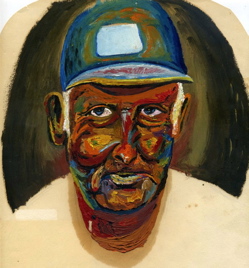Letting Go of Reality in Art
- The Insight
- L’s Guffaws
- “Do I really look like that?”
- “Your early paintings leaned towards reality?”
- Most have Recognizable Space and Objects
- Rendering Primitive, Untrained
- Engulfed by the Muse in his first Painting
- Hidden Figures & Spirals Epitomizes Style
- Ngady inspires Web-like lines
- Fall 1971 African Art Class from Cole & the Ngady Mask
- Oil Paints for Xmas ’71 & Mother’s significant influence
- Winter 72>74 Oil Sketches, The Womb, Art Lessons, The Drawing
- Self Portrait exhibits Ngady patterns – erratic Fabric inhibits progress
- First a Child-like attempt to mimic Reality?
- The Liberation of Color, Not Line and Palette
- Anxious Exhiliration
- On the Edge of Reality: The Sleeve – Vegetation, Fabric, or Impossible
- Dickinson Avocado or Stars in the Firmament?
- Special Effects unplanned, unintended, and unrecognized
- As with Reality – Complete Comprehension Doomed
The Insight
Over a decade ago in the midst of painting My 3 Women my Person had a deep insight into the nature of his art, which allowed him to finish his project and rise to a new level in painting. In his mind he had learned to “let go of reality” in his artistic expression. Further he was convinced that this would make the subsequent painting projects easier and more fun.
L’s Guffaws
Every time he made this comment his wife burst out laughing – inadvertently- spontaneously – almost sputtering in disbelief at the absurdity of this statement when applied to his visual creations. The intent of this paper is explore the true and false behind this assertion (applying the True–False Postulate) – investigating the subtleties and nuances of these two divergent points of view – hoping to discover something about the general nature of artistic expression, or at least about the artist’s vision.
“Do I really look like that?”

It’s easy to understand Wife L’s response when viewing his paintings, because many of his representations are based in pure abstraction – without even a slight nod to reality - for instance Laurie’s lovely, curly hair, which he has portrayed frequently in a variety of patterned stylizations - notably Tulum, but also My 3 Women, and in Master Ni - not to mention his constant segmentation of faces into countless tiny prisms. Indeed L’s face in Tulum has been regularly referred to as an iguana face. So for D, my person, to say that he was giving up reality – implied that he perceived his wife with iguana skin and some type of bubble hair – which was, of course, manifestly absurd. When the contradiction hit consciousness it exploded in merriment and hilarity at the paradox that he could be uttering these insane words so assuredly – as if he actually believed them. Not only that but he had the gall to sincerely maintain that his works were based in realism – which, of course, ignited more uproarious guffaws.
“Your early painting leaned towards reality?”

What did he mean? What are the truths behind his outrageous statement and assured belief?
He argued, “There is a continuum of representations from the pure abstract to pure photographic realism. Every work of art is between these two extremes. Prior to My 3 Women my painting were leaning towards reality. Now they lean towards abstraction.” More guffaws from the peanut gallery.
She can barely speak from merriment. “Lean towards reality?”
Most have Recognizable Space and Objects
“There are multiple scales of reality. One is recognizable space – another recognizable objects. In each of my paintings (save Master Ni and Ngady) the space is entirely recognizable and even somewhat creatable – Bur, Serena, Tulum, Chichinitza, and even my most recent painting, Maternal Love. Further in each of the paintings most of the objects are fairly recognizable. The faces are even personal and individual – not general.”
Rendering Primitive, Untrained
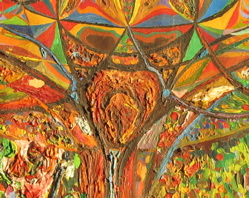
“Yet the rendering of his paintings is primitive and rough – lacking sophistication – obviously very little formal training - just moving from gut instinct – throwing himself at the canvas – intuitively and barbarically – sometimes for better – sometimes for worse. However because of occasional successes he was impelled to go on – not because he understood what he was doing – but because something good – even exquisite – had managed to emerge from the chaos of his unconscious – Wu Chi – the Primordial Womb – the subject and name of his first Painting.
Engulfed by the Muse to create his first Painting
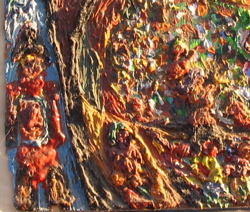
She overwhelmed him – both the intensity of the process and the resulting product – still does. Knowing nothing about the craft of oil painting – he went into a frenzy for, who knows how long (definitely prehistoric) - but probably months. In this divine possession he created a 3D painting with his oils – real ridges and valleys created by the laborious application of paint (still wet over 30 years later when this exquisite creation of the subterranean realms of consciousness was inadvertently squashed in the evacuation from the wild fire of 2009.)
He spent so long he commented at the time that he might devote his entire life to that one painting – engulfed as he was by the creative process – perhaps one of his initial possessions by the Muse. Again L, only his girlfriend at the time, smiled knowingly and said, “The rest of your life?”
Hidden Figures & Spirals Epitomizes Style
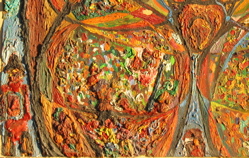
This crude object – an oil painting on construction paper of an obvious womb – still exists nearly 40 years later – a little worse for wear - as some parts have cracked off – but still revealing the raw genius, the inspiration behind the execution. It epitomizes the style of his paintings to come – the embedded, hidden figures, combined with lines, spirals, and eastern thinking – the Yin-Yang symbol.
Ngady inspires Web-like lines
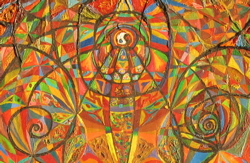
More importantly it reflected his attempt to recreate the underlying patterns of internal reality with many web-like lines – probably inspired by the ritual patterns on the Bushongo initiation mask of Ngady a Mwaash.
Fall 1971 African Art Class from Cole & the Ngady Mask
It all started innocently enough – taking an upper division undergraduate course in African art at UCSB. For his final paper he chose to write on the initiation wall of the Bushongo tribe of Central Africa. He found representations of three of the four deities – the masculine deities on the top and sides, but not the mother goddess at the bottom. In the midst of his research he happened upon Ngady. Stunned, fascinated, blown away, and probably high on psychedelics he drew the masks to illustrate his paper (no decent copy machines or scanners back then – had to do it by hand. Thank god!) Received a B- on the paper (didn’t use the primary French source.)
This experience changed his life. His amazement at the lines of force upon her mask face - and perhaps his facility for the recreation of this image (exhibiting an affinity for this style of art) – probably led him to attempt The Womb.
Oil Paints for Xmas ’71 and Mother’s significant influence
Let’s see. Finished the paper December 9, 1971. Got oil paints from my Mother for Xmas of the same year (still have the box). Note I never asked for oil paints, or even suggested it. I had been doing some casual abstracts and rough sketches with colored pencil and crayons. (I think she might have been upgrading me. Bless her.) Although resisting art for practical reasons – giving mixed messages - discouraging and encouraging – as all parents do – it was she who introduced me to painting – first with a paint by numbers kit in my teens – something to do when home from school sick, [still call my style paint-by-numberism] then by giving me oils for Xmas, which I still employ. Even though she was ambiguous about my talent and even my urge to art – it was she that supplied the materials that initiated this erratic life long obsession with oils.[1]
Winter 72: Oil Sketches
Winter ’72 did some oil sketches – mostly faces – only 3 (still in college at UCSB). Blown away by how easy it was – how naturally it came. But thought that anyone could do it. Never even showed these to my teacher until much later on. Upon viewing these sketches he said, "I've ruined you. Why didn't you show these to me before?" Still didn't show these primitive, unrefined outbursts of art to anyone else either - until nearly 40 years later – at which time daughters, friends and wife had a similar reaction to my teacher. "My favorite." – "You should have them framed." – "The spontaneity surpasses all your labored paintings." Each took just a few hours - maximum to execute. Just threw myself at the construction paper with the oils - no understanding whatsoever. I had, and still have, no idea what I'm doing.
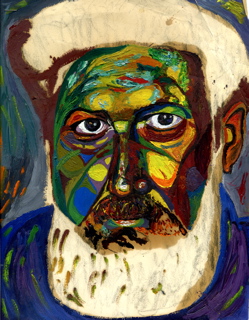
Winter 74 The Womb, Art Lessons, & The Drawing
Spring 1972 began The Womb; finished Summer ’72. (Another life long pattern revealed – months and even seasons to finish my paintings.) Met my Art Master, Brad Wright, December ’72.[2] 1973 Erratic art lessons (learning about the craft of oil painting and the nature of art) as I finish college. Winter 1974 Art assignment – draw a self-portrait. The Muse takes over again, as usual. This drawing supplied the lines for the painting I’m working on right now – Summer 2010 (over 36 years later).
Self Portrait exhibits Ngady patterns – erratic Fabric inhibits progress
As with The Womb, the Ngady mask was also a heavy influence on this drawing. The flowing lines of force – almost geometrical in nature – are in the hands, the face, the avocado, even the sky. Indeed the irregular fabric was the only element of the drawing left unfinished, and was perhaps even a paralyzing factor to the actual initiation of the painting. Indeed when reaching this section of the painting at the present time (the last part to be colored) there was a pause and sigh before moving forth. Perhaps the lack of easily identifiable order inhibited progress for a Left Brain control freak, like myself. But then the breakthrough - the outburst - into chaotic understanding. Breathtaking – as the sleeve of the shirt becomes the paradox that seems real – a great example of something on the edge of reality and abstract.
First a Child-like attempt to mimic Reality?
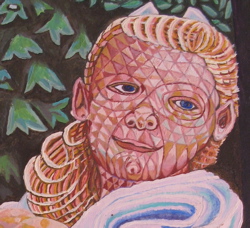
This brings us back to the original topic, letting go of reality. Prior to My 3 Women the Artist attempted to express reality to the best of his abilities – like a child might draw a landscape or figures (for instance enormous stylized eyelashes to represent girls). Both with their limited skills were attempting to represent something recognizable. Perhaps, and probably, bubble hair and iguana skin was the best he could do for Laurie’s head (or perhaps the Ngady mask inspired his lines of force style of representation). However despite the unusual style of rendering the Artist was still internally chained to the recognizable. (L laughing uncontrollably now.)
The Liberation of Color, Not Line and Palette
With the ‘letting go of reality’ Insight that occurred during the execution of My 3 Women he realized that the drawing suggested reality and that the colors just wanted to look good – without obstructing the intent of the drawing. Prior to this point he had tried to force the colors to look as real as possible. The insight liberated the paint/colors to become themselves – to achieve self-actualization on the board. The lines of the drawing and the palette colors were the rigid harmonic Fugue structure that Bach worked within to create his masterpieces. Setting the actual colors free meant that each session was much more spontaneous and fun – not so laborious.
Resulting Anxious Exhiliration
Of course the freedom leads to the anxiety of the accidental artist – as freedom tends to do.
“Maybe I’d rather get a paycheck. This entrepreneurial stuff is a bit overwhelming for little old me.”
But the only way – exhilarating and fresh – every session.
The Sleeve on the edge of Reality – Vegetation, Fabric, or Impossible
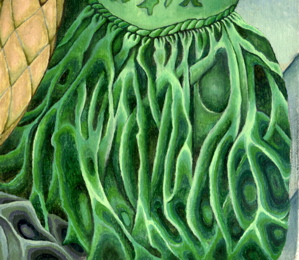
Back to the right sleeve of the young man in Self Portrait – a perfect example of the edge of reality and abstract. It epitomizes my artistic vision – what I want to say – over and over and over again. (Yet maybe never again. Who really knows?) Basically the area works as a recognizable object, the sleeve – undoubtedly – perhaps due to context. This level of reality is an essential part of D’s artistic vision. However a second glance reveals an intricate vegetal structure – perhaps suggesting entangled roots or vines. Certainly in the style of the picture – as the left hair looks like a pinecone. However these objects are unambiguous, not confused or mistakable with their unusual rendering in any way – obviously hair and sleeve – albeit exotic. With a more concentrated glance – the vines of the sleeve sometimes act like fabric, sometimes like vegetation, and sometimes like Escher-like impossibility – foreground-background, inside-outside confusion – perhaps smoke-like in its variability. Before the Insight the Artist would have attempted to resolve every confusion – bring order to chaos. Now D attempts to fragment reality – establishing it with Line and fracturing it with Color.[3]
Dickinson Avocado or Stars in the Firmament?
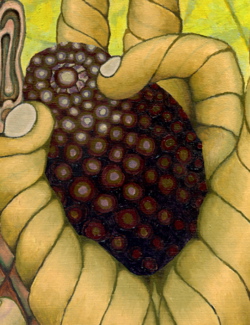
Another section from this painting that illustrates the Edge of Reality principle is the avocado – obviously some kind of dark fruit or vegetable held in the subject’s right hand. My father-in-law Ted immediately identified its nature – a Dickinson avocado, as opposed to Haas. Obviously its recognizable reality is high – not just any avocado, but a specific variety that came from the Tree - the huge avocado tree in our bachelor yard of the house that my Person lived in at the time of the drawing. So while the fruit is clearly real, the representation suggests the firmament of heaven – with stars sparkling in the darkness. This is why Laurie deemed it a cosmi-cado (cosmic avocado – duh!) The solidity of the fruit dissolves in the celestial vision of the blackness behind a starry night. (“Not quite. Stars are never as regular as that.” L)
Special Effects unplanned, unintended, and unrecognized

Although the objects of the painting are totally recognizable and located in a distinct space, the sleeve is vegetation, the avocado the firmament of heaven, the hair a pinecone and the sky and face ceramic tiles. None of this was planned before I started. Indeed none of the effects were intended, or even attempted with the Brush/Hand Eye/Mind connection in the execution. Indeed each of the special effects was noticed after completion – certainly not during or before. In the midst it was more of a “Whoa! I like those colors and treatment. Let us pursue the effect to completion. Wow! This is cool.”
Maybe a few days, weeks, or even months later, or after someone else noticed: “Oh. That looks like a pinecone. Was wondering what it reminded me of.” (Even the insights of this paper were discovered in the writing – not before.)
As with Reality – Complete Comprehension Doomed
Further it is doubtful that I could have achieved any of the effects if I had tried. Just an accidental artist – attempting to move to the edge of reality – suggesting the paradox – with things not being quite as they seem – that any attempt to really understand is doomed – especially the closer one looks. “You really don’t know what is happening here. Do you, Mr. Jones.”
